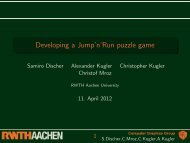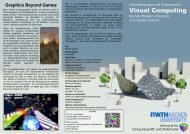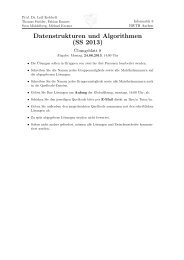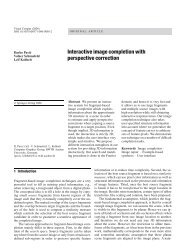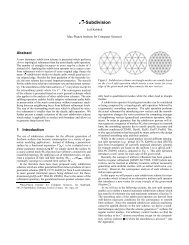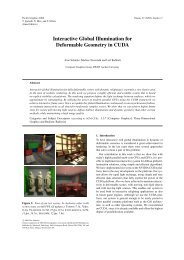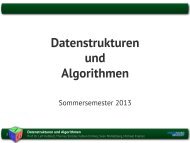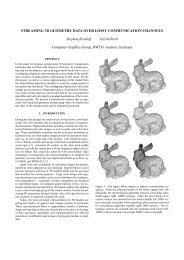Structure Preserving CAD Model Repair - OpenFlipper
Structure Preserving CAD Model Repair - OpenFlipper
Structure Preserving CAD Model Repair - OpenFlipper
You also want an ePaper? Increase the reach of your titles
YUMPU automatically turns print PDFs into web optimized ePapers that Google loves.
Stephan Bischoff & Leif Kobbelt / <strong>Structure</strong> <strong>Preserving</strong> <strong>CAD</strong> <strong>Model</strong> <strong>Repair</strong><br />
Figure 1: Our algorithm converts a tessellated <strong>CAD</strong> model into an intersection-free and closed triangle mesh which covers<br />
all gaps up to a prescribed size. Left: The input patches were created by tessellating a <strong>CAD</strong> model consisting of 385 trimmed<br />
NURBS surfaces. Middle: A standard volumetric reconstruction algorithm resamples the model globally and destroys any<br />
structure of the tessellation. Right: Our algorithm only resamples the model locally in regions around artifacts like gaps and<br />
intersections and thus preserves most of the input tessellation.<br />
regions that are away from these inconsistencies. We are<br />
thus able to preserve any characteristic structure (e.g. isoparameter<br />
or curvature lines) that might be present in the<br />
input tessellation. Our algorithm closes gaps up to a userdefined<br />
maximum diameter, resolves intersections and overlaps,<br />
handles incompatible patch orientations and produces<br />
a feature-sensitive, manifold output that stays within a prescribed<br />
error-tolerance to the input model.<br />
The basic idea is to first identify the critical regions containing<br />
artifacts like gaps and overlaps, then selectively applying<br />
a volumetric reconstruction algorithm in these regions<br />
and finally joining the reconstruction with the unmodified<br />
outside components. Due to its selectivity our algorithm<br />
is on the one hand able to achieve high grid resolutions and<br />
thus a high reconstruction quality near the artifacts, but on<br />
the other hand does not incur the performance overhead of<br />
algorithms that globally reconstruct the input.<br />
2. Previous Work<br />
Surface-based algorithms work directly on the input tessellation<br />
and use a number of techniques to detect and resolve<br />
artifacts. These techniques include, e.g. snapping boundary<br />
elements onto each other, projecting and inserting boundary<br />
edges into faces, explicitly computing the intersections<br />
between faces, propagating the normal field from patch to<br />
patch [BW92, BS95, BDK98, GTLH01, MD93], stitching<br />
small patches into gaps [TL94, Lie03], resolving topological<br />
noise by identifying and cutting handles [GW01], etc.<br />
Surface-based approaches only locally modify the input<br />
geometry in a small region around the artifacts. Hence, the<br />
input tessellation is preserved wherever possible. However,<br />
these approaches usually cannot give any guarantees on the<br />
quality of the output: There might be no globally consistent<br />
orientation of the input patches; certain artifacts, like overlapping<br />
geometry or “double walls” are hard to handle; intersections<br />
are difficult to detect and to resolve; due to numerical<br />
issues a robust and efficient implementation is challenging.<br />
Volume oriented approaches convert the input into a volumetric<br />
representation, i.e. a signed distance field or a grid<br />
of directed distances [NT03, Ju04, FPRJ00]. From this volumetric<br />
representation one then extracts a surface using techniques<br />
like marching cubes [LC87, KBSS01] or dual contouring<br />
[Gib98, JLSW02, Ju04].<br />
Volumetric techniques produce guaranteed manifold output.<br />
Furthermore, topological artifacts and holes can easily<br />
be removed using various filter operations on the volume<br />
[ABA02,DMGL02,NT03]. On the downside, however,<br />
the conversion to and from a volume acts as a low-pass filter<br />
that removes sharp features and leads to aliasing artifacts<br />
in the reconstruction. Furthermore, due to the global resampling,<br />
the structure of the input patches is completely destroyed<br />
and the output is usually highly over-tessellated.<br />
3. Algorithm<br />
The input to our algorithm is a tessellated <strong>CAD</strong> model<br />
M 0 = {P 1 ,...,P n} which consists of n patches P i . Each<br />
patch P i is a manifold triangle mesh and is uniquely identified<br />
by its patch ID i. Furthermore, the user prescribes an<br />
error tolerance ε 0 and a maximum gap diameter γ 0 . The output<br />
is an intersection-free and closed triangle mesh T that<br />
approximates M 0 up to a maximum error of ε 0 and covers<br />
all gaps of diameter ≤ γ 0 . Our algorithm proceeds in several<br />
stages (see Figure 2):<br />
c○ The Eurographics Association and Blackwell Publishing 2005.



